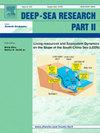晚第四纪东北印度洋碳埋藏的一次大冰期-间冰期转移
IF 3
3区 地球科学
Q2 OCEANOGRAPHY
Deep-sea Research Part Ii-topical Studies in Oceanography
Pub Date : 2025-07-21
DOI:10.1016/j.dsr2.2025.105518
引用次数: 0
摘要
碳是地球上常见的元素,以各种分子形式存在。然而,化石燃料燃烧产生的二氧化碳(CO2)释放到大气中,由于其潜在的温室效应,是一个主要问题。海洋通过有机碳(Corg)和无机碳(CaCO3)的封存,将其长期埋在沉积物中,帮助清除大量的大气二氧化碳。海洋储存碳的能力随时间而变化,这取决于几个因素,这使得预测大气中二氧化碳的未来命运变得具有挑战性。东北印度洋特别容易受到人类活动的影响,因为人类活动可能会改变它在海底沉积物中储存碳的潜力。因此,了解该地区碳埋藏如何随时间变化是至关重要的。利用19个岩心(3个新岩心和16个已发表岩心)的有机碳(Corg %)、碳酸钙(CaCO3 %)、总碳(TC)、有机碳氮比(Corg/N)、稳定碳(δ13C)和氮(δ15N)同位素比值数据,揭示了东北印度洋碳埋藏的盆地尺度变化。我们报道了在冰期-间冰期期间,东北印度洋边缘海区和开放海区的碳埋藏发生了显著变化。此外,海洋的不同区域储存了不同数量的碳,这表明自最后一次消冰期以来碳埋藏具有很强的空间异质性。末次盛冰期(LGM),深海沉积物CaCO3含量下降,陆架沉积物CaCO3含量上升。Corg丧葬模式的情况则正好相反,值高于最近整个LGM LGM期间和Corg含量最高。全盆地CaCO3和co2含量最低的时期为格陵兰期和北格里普期。边缘海碳埋藏变化主要受季风生产力、沉积速率、沉积物结构和溶解氧浓度的影响。另一方面,水质量的变化主要推动了更深区域的碳埋藏。这一发现将有助于评估该地区在变暖世界中的碳埋藏潜力。本文章由计算机程序翻译,如有差异,请以英文原文为准。
A large glacial-interglacial shift in carbon burial in the northeast Indian Ocean during the Late Quaternary
Carbon is a common element on Earth, found in various molecular forms. However, the excessive release of carbon dioxide (CO2) into the atmosphere from burning fossil fuels is a major concern due to its greenhouse potential. The oceans help remove a significant amount of atmospheric CO2 through organic (Corg) and inorganic carbon (CaCO3) sequestration, burying it in sediments for a long time. The ocean's ability to store carbon varies with time, depending on several factors, making it challenging to predict the future fate of atmospheric CO2. The northeast Indian Ocean is particularly vulnerable to human activities that could alter its potential to store carbon in the bottom sediments. Therefore, it is crucial to understand how carbon burial has changed in this region over time. We provide basin scale changes in carbon burial in the northeast Indian Ocean by using organic carbon (Corg %), calcium carbonate (CaCO3 %), total carbon (TC), organic carbon to nitrogen ratio (Corg/N), stable carbon (δ13C) and, nitrogen (δ15N) isotopic ratio data from a total of 19 cores (3 new and 16 previously published). We report a significant change in carbon burial in both the marginal marine and open ocean regions of the northeast Indian Ocean during glacial-interglacial intervals. Additionally, different regions of the ocean stored varying amounts of carbon, indicating a strong spatial heterogeneity in carbon burial since the last deglaciation. During the last glacial maximum (LGM), sediments' CaCO3 content decreased in the deep sea but increased on the shelf. The opposite was true for Corg burial patterns, with values higher than recent throughout the LGM, and the highest Corg content during LGM. The basin-wide lowest CaCO3 and Corg content was during the Greenlandian and Northgrippian. Marginal seas' carbon burial changes were mainly influenced by monsoon-induced productivity, sedimentation rate, sediment texture, and dissolved oxygen concentration. On the other hand, water mass changes primarily drove carbon burial in deeper regions. The findings will help in assessing the carbon burial potential of this region in the warming world.
求助全文
通过发布文献求助,成功后即可免费获取论文全文。
去求助
来源期刊
CiteScore
6.40
自引率
16.70%
发文量
115
审稿时长
3 months
期刊介绍:
Deep-Sea Research Part II: Topical Studies in Oceanography publishes topical issues from the many international and interdisciplinary projects which are undertaken in oceanography. Besides these special issues from projects, the journal publishes collections of papers presented at conferences. The special issues regularly have electronic annexes of non-text material (numerical data, images, images, video, etc.) which are published with the special issues in ScienceDirect. Deep-Sea Research Part II was split off as a separate journal devoted to topical issues in 1993. Its companion journal Deep-Sea Research Part I: Oceanographic Research Papers, publishes the regular research papers in this area.

 求助内容:
求助内容: 应助结果提醒方式:
应助结果提醒方式:


